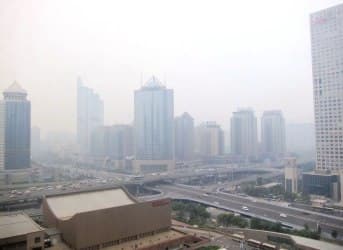The “Blackest Day,” is how The Economist called January 12 when the Air Quality Index (AQI) in Beijing rose to a record 755. It was “Beyond index” on a scale where the worst level, “Hazardous,” ranges from 301-500 and carries this warning: “Everyone should avoid all physical activity outdoors; people with heart or lung disease, older adults, and children should remain indoors and keep activity levels low.”
On that day, airborne particulate matter smaller than 2.5 microns in diameter (PM 2.5) reached 886 micrograms per cubic meter, about 35 times the guideline set by the World Health Organization. These particulates contain “sulfate, nitrates, ammonia, sodium chloride, carbon, mineral dust, and water” that form a “complex mixture of solid and liquid particles of organic and inorganic substances.” They contribute to cardiovascular and respiratory diseases, and lung cancer. Mortality in polluted cities exceeds that “in relatively cleaner cities by 15–20%.” The WHO estimated in 2007 that 656,000 Chinese died of air pollution every year, and another 95,600 from water pollution. Surely, this hasn’t gotten any better since.
Among the culprits: coal consumption. It has been on an uninterrupted tear since 2000 as China built a phenomenal number of coal-fired power plants (users of steam coal) and as it expanded its steel and iron industries (users of metallurgical coal). Bubble projects, overcapacity, construction of ghost cities, motor vehicles that turn the exploding net of roads and highways into clogged parking lots.... The excesses are everywhere. And power generating capacity from 2005-2011 doubled, of which 80%—despite efforts to diversify—still comes from coal.
Related article: Sell US Coal to China and Watch Carbon Emissions Fall
China consumed 1.5 billion tons of coal in 2000, or 28% of total world consumption. By 2011, according to a just released report by the US Energy Information Agency, coal consumption had jumped 153% to 3.8 billion tons, amounting to 47% of total coal consumption in the world. Demand had increased an average of 9% per year! If the China bubble doesn’t accidentally get pricked in the interim, the country will consume more coal in 2013 than the rest of the world combined.
In that “rest of the world,” however, coal consumption has had a hard time, increasing only 1% on average per year over the 12-year period. Fingers are pointing at the US, once the largest coal market, until China came along. Much of the coal-consuming iron and steel industries in the US have migrated across the Pacific, and coal as a fuel for power generation has been on a long structural decline [read... Natural Gas And The Brutal Dethroning of King Coal].
The numbers are epic. China has more power generating capacity than any other country. In addition to being by far the largest consumer of coal, China is also the largest producer and has the third-largest coal reserves. Despite these superlatives, it was only the fourth-largest consumer of natural gas in 2011, though consumption jumped 50% from 2009. Nuclear power, with 15 reactors on line as of mid-2012, provides only a tiny portion of total power generation, but 26 (!) reactors are under construction [here is my article about its sideshow: Blowing Up: The Transfer Of French Nuclear Technology To China]. And renewables? Minuscule. But growing in leaps and bounds, of course.
Related article: China Invests in Ukraine Coal Gasification
As these alternatives are desperately trying to gain critical mass, coal consumption will continue to grow—and the pollution record of January 12, as horrid as it was, will turn out to be just another line item on a long list of surpassed records. The “Blackest Day” is still in the future.
While we on the West Coast get to breathe the airborne crap that makes it across the Pacific, there are opportunities for the US in China’s coal-fired bubble economy: coal exports. In 2012, the US exported an estimated 125 million tons of coal. It broke the prior record set in 1981 and was more than double the level of 2009. However, coal production in the US still declined. It’s tough out there.
Despite the frenetic growth in coal consumption in China and certain other parts of Asia, the US exported much more coal to ... Europe! Coal has been very competitive in Europe where natural-gas prices are so high that land-locked producers in the US get water in their eyes when they think about it. In countries like Germany and Belgium that were once coal mining bastions, coal production (and consumption) has been in free-fall. So US producers were able to export 42 million tons to Europe. To Asia, they shipped only 23 million tons—but this too is on the upswing. Even, if in a few years, people in Beijing are trying to figure out how to breathe the air outside.
To supply its bubble economy with raw materials and fossil fuels, regardless of the consequences, China has embarked on an all-out resource grab, in every direction. Its tentacles spread far and wide. Oil is on top of the list. Hence the moves in Iraq, where turmoil has created opportunities. Read.... It Wasn’t Supposed To Be This Way: Chinese Oil Companies Apparent Victors in Post-Saddam Iraq.
By. Wolf Richter



















Trouble is, some of that cr@p eventually makes its way over here to the US. The dirtier they get, the dirtier we do to. As I said before. LFTRs!